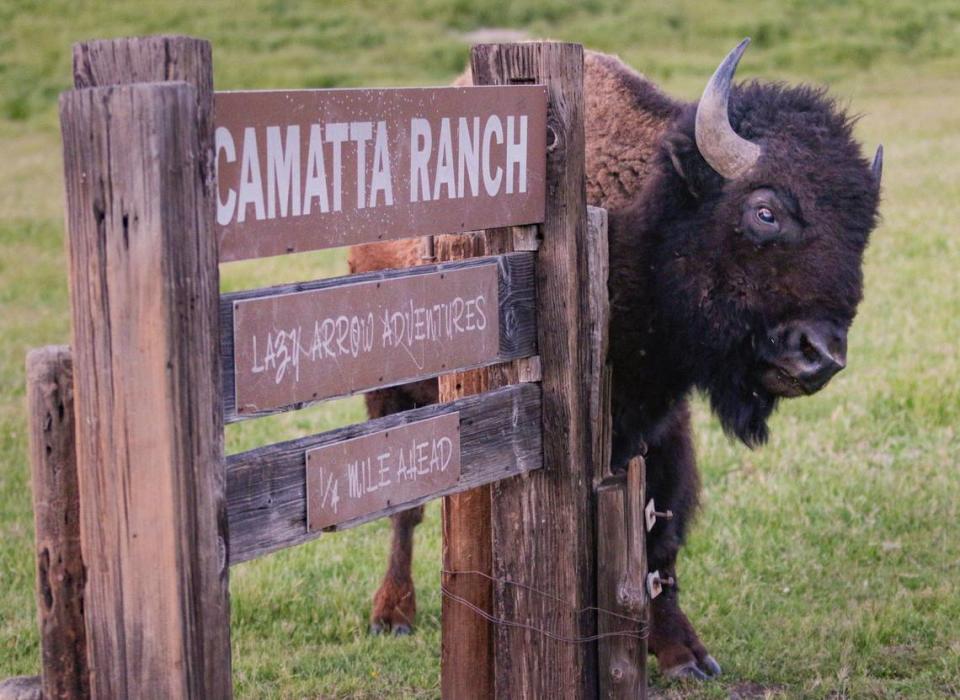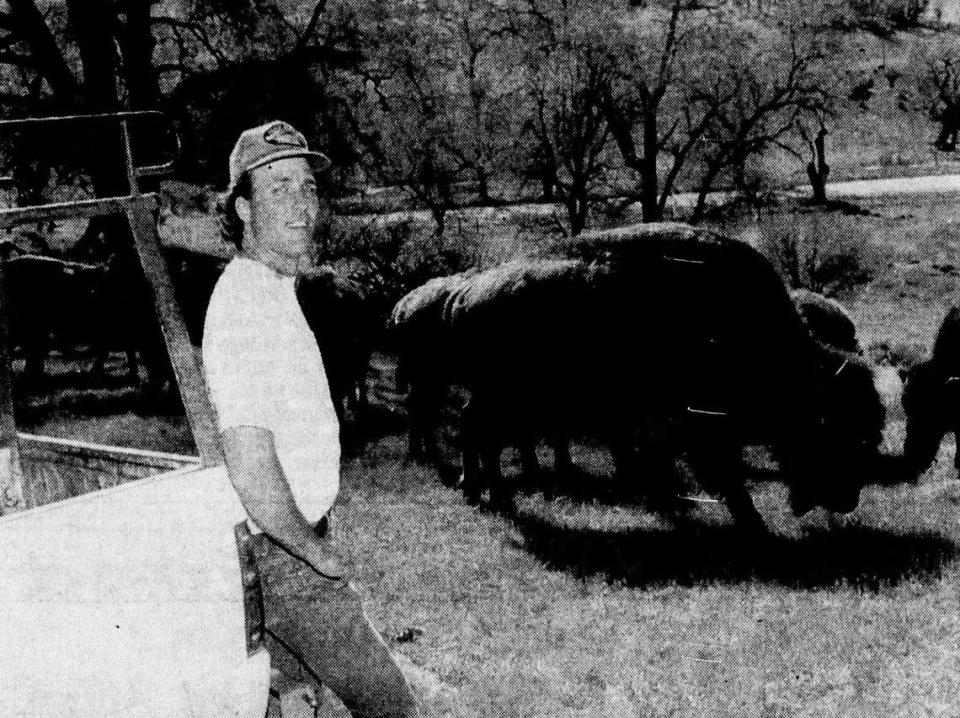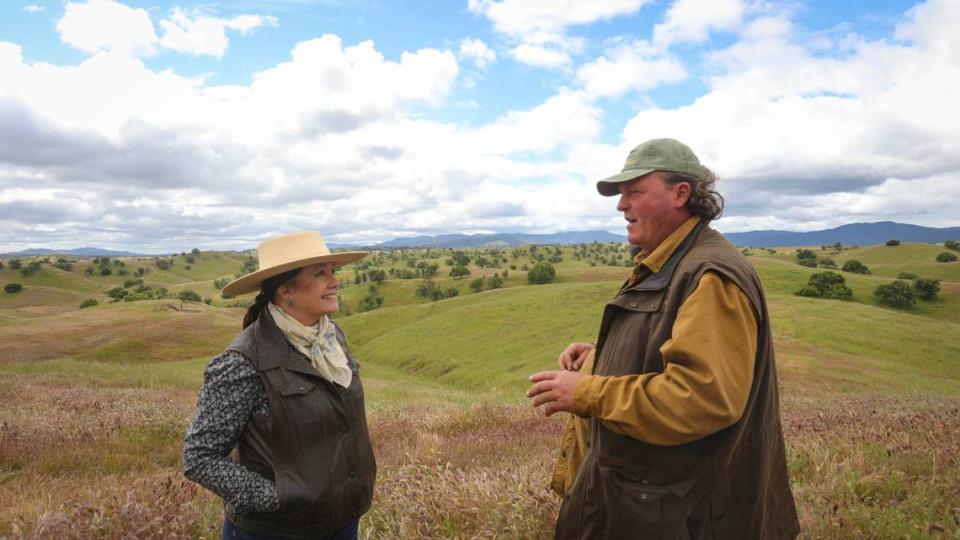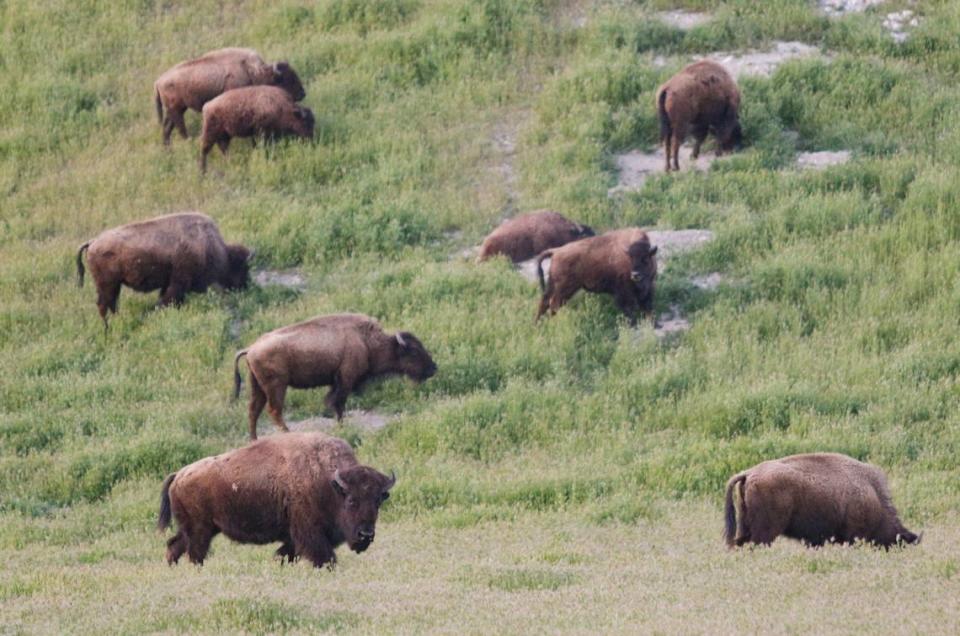Massive ranch is where the buffalo roam in SLO County. But how did they get there?
The Camatta Ranch has been in the news with a landmark preservation deal announced with the Land Conservancy of San Luis Obispo County.
With that deal, an area in eastern San Luis Obispo County nearly the size of San Francisco has been placed under a conservation easement.
If you have seen American bison grazing beside Highway 58 on the way to the Carrizo Plain then you are at the Camatta Ranch.
This story by Chuck Bolcom was published in the then Telegram-Tribune May 6, 1993. Unfortunately the original images from that story are lost in the files, but there are images from more recent times.

Where the buffalo roam
The image is so startling people pull off the road and stare.
They point.
They snap photos.
They can’t believe they’re seeing a herd of buffalo grazing on the green hills of San Luis Obispo County.
This is, after all, the Central Coast, not the great plains of South Dakota.
But if you head out on Highway 58, at the right time, you’ll see them yourself: 16 North American bison, munching on the green grass of the Camatta Ranch.
Some motorists are so shocked they don’t even bother to pull off the road.
“I’ve seen people park in the middle of the road and take a picture,” said ranch manager Mark Morrison.

Morrison acquired his first bison about six or seven years ago at the Templeton Livestock Market. A buffalo for sale is unusual and as soon as he saw the male yearling, Morrison knew he had to have him.
“I wanted that buffalo,” Morrison said. “It was something different, and you have to remember, this is a ranch.”
Not his ranch, mind you. His parents actually own the spread.
But with 32,000 acres, the family has a little more room for their animals than most.
Morrison stated the herd because he loves animals, all kinds of animals.
His wife, Felicia, says her husband comes home with new animals all the time.
“I’ve always said one of these days I’m going to put out a sign outside that says ‘Mark’s Ark,’” she said.

Through the years, Morrison has acquired aoudad (a North African sheep), Barbado sheep, Jacobson four-horn sheep, fallow deer, Ankole-Watusi cattle, snow geese, greater Canadian honker geese, several types of ducks, various hens and birds, horses, goats, a black swan and a water buffalo named Biff.
Biff has a problem. He still hasn’t figured out who he is.
When he runs around with horses, he thinks he’s a horse.
When he runs around with the sheep, he thinks he’s a sheep.
Most water buffalo like water. Not Biff — at least, not at first.
“I remember a couple of years ago it began raining and a lot of the animals ran into the shed,” Morrison said. “When I went to check on them, there’s Biff behind everybody else trying to keep dry.”
But Biff is still in one piece, which is more than can be said for Bent Horn.
She weighs 800 pounds and she has a bent horn from running after a horse and crashing into a fence post.
“She just doesn’t like horses,” he said. “She must have been really abused by someone on horseback because none of the other buffalo hate horses.”
The other bison have their quirks. Some are friendly. Some are shy.

“Some of them will check you out, at first,” Morrison said. “They’re just as curious about us as we are about them.”
Rank has its privileges in the buffalo world. The older, bigger buffalo eat when they want. The younger ones have to wait their turn.
And one bull is boss.
Morrison doesn’t have a name for him, but he’s the largest one in the herd. All he as to do is start walking toward the younger males and “they’ll start running,” Morrison said.
Buffalo are known to be temperamental. If someone starts running around, waving their arms and making a lot of noise, they will run, Morrison said.
And when that happens look out. Bison run like deer, he says; some can outrun horses.
Morrison developed his love of animals at a young age. His mother used to give tours at the Los Angeles Zoo and he often came along.
“It was kind of like my backyard,” he said. “I was fascinated with animals.”
When he wasn’t at the zoo, Morrison was often helping out his dad, a veterinarian who ran a 24-hour emergency animal clinic in Woodland Hills.
“People would hit a deer and bring it in saying, ‘Do whatever you have to do to save it,’” Morrison said. “So my dad would take care of it. Sometimes he would bring the animal home while it was mending.”
Morrison isn’t the only buffalo owner in the county, but he may have the largest herd.
“Every once in a while, you’ll see a buffalo in San Luis Obispo,” he said. “Actually it’s kind of sad because they’re usually in a small pen and they can’t run around.”
At the ranch, the buffalo have 300 acres to roam as they please. They don’t share their space with anyone.

Morrison keeps his animals apart for good reason. He also raises cattle on the ranch and if a cow were to meet up with a male bison.
Well … the two could produce a beefalo.
There is such an animal, Morrison said, but he’s never tried to create one because the cow might have trouble giving birth.
But some people do raise buffalo for their meat. Buffalo cuisine is a growing market. McLintocks Saloon and Dining House even serves a buffalo burger.
“It’s good,” Morrison said. “It’s really hard to tell the difference between a buffalo burger and a regular burger.”
Raising buffalo isn’t cheap. Although the herd is eating of the land right now, Morrison usually feeds his bison once a day with alfalfa and oat hay.
With some bison weighing up to two tons, the food bills alone are enormous.
How much? Morrison won’t say.
“That’s between me and my accountant,” he said.
Despite the cost, the family plans to keep building the herd. They’ve got the space and they’re offering ranch tours for anyone who wants a closer look at the buffalo.
Perhaps you don’t really care about the buffalo, but you would love to see the wildflowers or the fossils at the ranch. The family will arrange for a hike and picnic.
Maybe feeding the animals sounds more exciting. You can tag along for the early morning feeding and enjoy a breakfast afterward.
Maybe a drive at sunset suits your fancy.
The point is there’s plenty to do. The family only requests you call in advance and make a reservation.
Despite the cost, Morrison says he’ll keep building his herd.
He’s got the space. Buffalo cuisine could become the latest rage.
Besides, there’s nothing quite like owning your own herd.
“They’re just part of the family,” he said. “You raise a lot of animals and they grow on you. And then you want more and more.”

